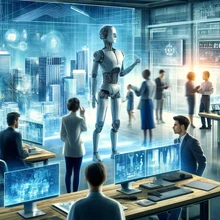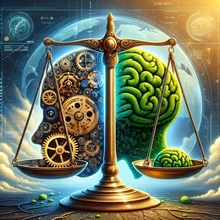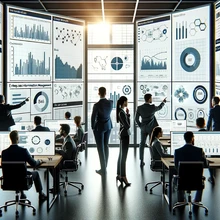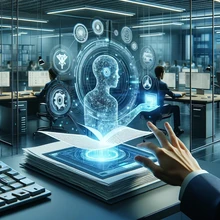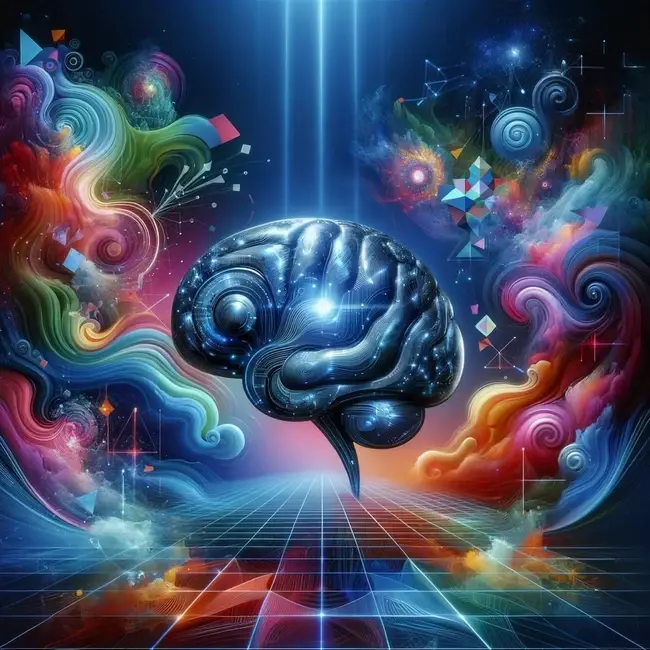
Forget the fear-mongering – AI isn't here to replace designers. Instead, imagine it as the ultimate creative sidekick. It can handle tedious tasks, generate fresh ideas, and unlock exciting possibilities. In a recent episode of Disambiguation I interviewed two executives from DXM, an AI design tool for brands. It was a great conversation, you should check out the whole episode, but one important takeaway is the concept that AI for creatives is human augmentation, not human replacement. Let’s look at how to harness the power of AI, opening up a world of new design opportunities.
Key Areas of AI Use in Creative Design
Generative Design:
Text-to-Image Generators: Create images from descriptions (e.g., DALL-E 2, Midjourney, Stable Diffusion, DXM). This revolutionizes concept creation and rapid idea exploration.
Logo Generators: AI can produce multiple logo design options based on user input.
Website and UI Design: AI can help generate layouts and suggest design elements that optimize user experience.
Image and Video Enhancement:
Image Upscaling and Restoration: Improve image quality, fix old photos, and enhance details.
Colorization: Colorize black and white videos and photos.
Style Transfer: Apply artistic styles of famous paintings to existing images or videos.
Content Creation Assistance:
Copywriting: AI can generate product descriptions, ad copy, creative text, and even assist with longer-form writing.
Music Composition: Create unique melodies, harmonies, and even full songs based on specific parameters.
Workflow Optimization:
Image Tagging and Organization: Automatically categorize images for better asset management.
Font and Color Palette Selection: AI tools offer suggestions based on design principles and trends.
Repetitive Task Automation: Streamline processes like resizing images, background removal, etc.
Examples of AI Impact
Graphic Design: AI helps in rapid prototyping, removes mundane tasks, and suggests layout improvements based on user data.
Fashion Design: AI can generate new clothing patterns, analyze trends, and predict future styles.
Interior Design: AI can assist with room layouts, furniture selection, and realistic visualization.
Web Design: AI can suggest user-friendly interface designs and help build personalized websites.
Considerations
AI as a Tool, Not Replacement: AI excels at generating ideas and optimizing processes, but human designers provide the essential creative direction, storytelling, and emotional connection.
Ethics and Originality: It's important to use AI responsibly to avoid plagiarism or infringing on the work of other artists.
Evolving Landscape: AI in design is constantly evolving, leading to new possibilities and potential disruptions.
Brand Consistency
One of the biggest challenges of using AI for creative design is ensuring designers use brand standards and ensure consistency across the portfolio of designs. This could be done manually in the prompt building process, although this is not the easiest method to scale and to guarantee brand compliance to the standards. Some tools are building in a brand standards template that is used by the AI application across all designs ensuring brand consistency by default. Writesonic, for example, has a brand voice template and knowledge base to support its writing and image tools. Perhaps the most interesting and complete offering is from DXM, called AI Brand Profile™. As more brands incorporate AI creative design tools in their workflow, a robust method to maintain brand voice and consistency is critical.
The Future of AI in Design
The future of AI in creative design isn't about humans versus machines, but rather about a powerful synergy. AI is transforming the way designers work. Imagine AI as an inexhaustible wellspring of inspiration, handling the technical drudgery while designers focus on high-level concepts, emotional resonance, and injecting that essential human touch. AI will analyze vast amounts of data to inform design trends, predict user preferences, and ensure a seamless experience across different platforms. The creative industries will see entirely new forms of art and design emerge – experiences driven by AI's generative capabilities yet guided by the designer's unique vision. This partnership will empower both established professionals and passionate newcomers, democratizing the creative process while pushing the boundaries of what we consider art and design.




